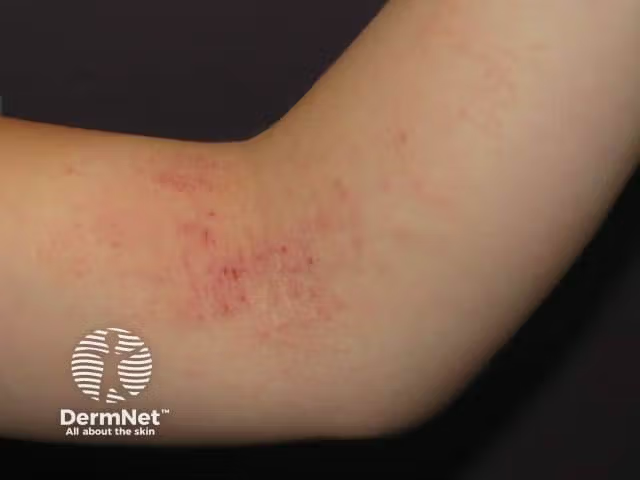- Case-Based Roundtable
- General Dermatology
- Eczema
- Chronic Hand Eczema
- Alopecia
- Aesthetics
- Vitiligo
- COVID-19
- Actinic Keratosis
- Precision Medicine and Biologics
- Rare Disease
- Wound Care
- Rosacea
- Psoriasis
- Psoriatic Arthritis
- Atopic Dermatitis
- Melasma
- NP and PA
- Skin Cancer
- Hidradenitis Suppurativa
- Drug Watch
- Pigmentary Disorders
- Acne
- Pediatric Dermatology
- Practice Management
- Prurigo Nodularis
- Buy-and-Bill
News
Article
Expert Insights on Personalizing Atopic Dermatitis Treatment
Author(s):
Key Takeaways
- Recent advancements in AD management include novel therapies like nemolizumab and tapinarof, targeting specific pathways and addressing underlying mechanisms.
- Transitioning from corticosteroids to sustainable treatments, such as biologics, is crucial for long-term control and improved patient outcomes.
New drugs targeting IL-4, IL-13, and IL-31 pathways provide options for tailored eczema treatments.

Atopic dermatitis (AD) remains a significant challenge for clinicians despite remarkable advancements in therapeutic options. At a recent Dermatology Times Case-Based Roundtable event, Peter Lio, MD, a clinical assistant professor of dermatology and pediatrics at Northwestern University Feinberg School of Medicine in Chicago, Illinois, highlighted essential insights into the evolving strategies for managing AD, focusing on advanced therapies and patient-centric approaches.
Breakthroughs in Treatment Options
The discussion emphasized the unprecedented developments in the treatment landscape for AD. As Lio noted, “This is such a crazy, exciting time. We have so many new things. [Two new things]got approved [in December 2024]: nemolizumab [Nemluvio; Galderma] and tapinarof [Vtama; Organon]. It’s crazy.”
The group noted how the introduction of advanced biologics and nonsteroidal therapies has revolutionized care, allowing for tailored treatment approaches. Lio shared that these innovations have made it possible to treat patients who previously had no viable options, underscoring the importance of staying updated on the latest approvals.
The conversation also touched on the mechanisms of action for these treatments. Dupilumab (Dupixent; Regeneron Pharmaceuticals, Inc), for instance, targets IL-4 and IL-13 pathways, whereas nemolizumab blocks IL-31, often referred to as the master itch cytokine. As Lio explained, “IL-31 is doing other things too. It’s playing a role in inflammation, fibrosis, and skin barrier damage.”This multifaceted approach addresses not only symptoms but also underlying pathophysiological mechanisms.
Balancing Short-Term Relief and Long-Term Control
Patients often rely on corticosteroids for immediate relief, but experts attending the roundtable noted prolonged use raises concerns. Lio stated, “I am not completely against steroids…but I just get worried when people are leaning on them. This is going to be bad; we’re going to end up in a bad place.”The panel discussed strategies to transition patients from steroids to more sustainable options, such as nonsteroidal topicals and biologics.
A case study illustrated the impact of advanced therapies. A 27-year-old woman with extensive eczema covering 20% of her body surface area experienced significant pruritus and reduced quality of life. Despite her consistent use of moisturizers and topical steroids, her condition remained severe. The decision to initiate dupilumab, combined with intermittent topical steroid use, proved transformative. “This seems like a systemic patient, totally fits,” remarked one participant, highlighting the need to individualize treatment plans based on disease severity and patient history.
Challenges in Therapeutic Decision-Making
The selection of appropriate therapy involves multiple considerations, including patient history, comorbidities, and prior treatments. The panel acknowledged the importance of addressing both physical and psychological aspects of AD. Lio noted, “When I think of atopic dermatitis, I think about all those different pieces…skin barrier damage, microbiome dysbiosis, the inflammation, the itch, and then we have the behavioral piece too.”
To optimize outcomes, participants emphasized the role of education and realistic goal setting. One clinician shared, “I typically just tell them, at least initially, this is not necessarily a replacement.…Underpromise and then overdeliver.” This approach helps manage expectations while fostering trust and adherence.
Transitioning Between Therapies
The discussion highlighted the importance of adaptability in treatment. Some patients may not respond adequately to their initial therapy or may experience secondary failures. One participant said, “I had 2 patients recently. They’re in their 20s. One was doing amazing on [dupilumab]. She thought her eczema was cured, and she decided to go off it. But it ended up coming back and she needed to go back on, so we reinitiated.
“The other patient, she never cleared completely. We [did a patch test on] her; she was safe listed, everything, but she never cleared as well as all my other [dupilumab] patients. They both started having arthralgia [the summer of 2024], and they’re in their 20s.”
These cases demonstrate the need for close monitoring and willingness to switch therapies when necessary.
The panel debated how to approach switching biologics. For primary nonresponders to dupilumab, some clinicians advocated trying alternative IL-13 inhibitors, such as tralokinumab (Adbry;LEO Pharma) or lebrikizumab (Ebglyss; Eli Lilly). Others suggested exploring different mechanisms of action, such as Janus kinase inhibitors or IL-31 inhibitors, for broader efficacy.
Addressing Gaps in Care
A recurring theme was the need to bridge gaps in care, particularly for severe cases that go undiagnosed or undertreated in primary care settings. A participant observed, “I’ve had [patients with very severe AD]finally come into the office after 10 years of dealing with AD.…It scares me.”
The panel agreed that enhancing primary care education and improving referral pathways are critical for timely diagnosis and treatment.
Patient-Centric Approaches
The discussion emphasized the importance of individualized care, addressing both medical and lifestyle factors. One clinician noted, “My goal is for you to be happy about your skin, not just tolerating it.” Participants also highlighted the role of nonpharmacological interventions, such as phototherapy, and lifestyle modifications, including optimizing moisturization routines and addressing potential triggers, such as allergens.
The conversation underscored the value of building rapport and involving patients in decision-making. Lio said, “I think patients do love the idea that they’re not necessarily trapped on [a treatment] and that there is some hope.” This sentiment reinforces the importance of empowering patients through education and shared goal setting.
Conclusion
The evolving landscape of AD management offers new hope for patients, with advanced therapies enabling personalized and effective care. However, challenges remain in optimizing treatment selection, addressing gaps in care, and balancing patient expectations. Lio concluded, “It is in our best interest and our patients’ best interest to fight for them as best we can.…This is a person who’s really suffering and needs this.”
The insights shared during this discussion highlight the importance of collaboration, education, and innovation for improving outcomes for patients with AD.






